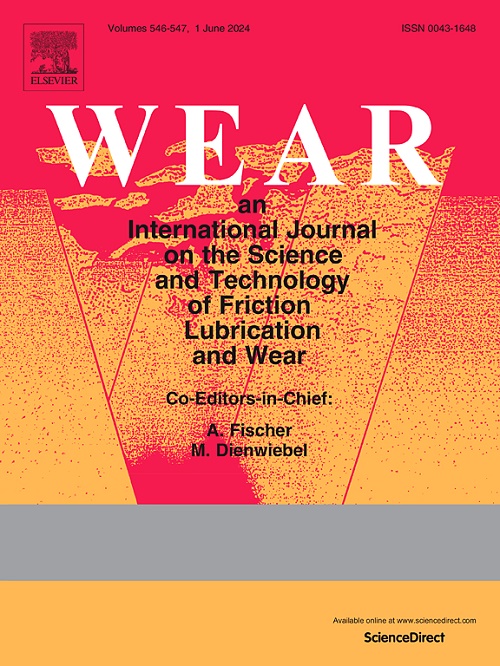新型 Al80Mg10Si5Cu5 多组分合金的磨损特性
IF 5.3
1区 工程技术
Q1 ENGINEERING, MECHANICAL
引用次数: 0
摘要
本研究调查了一种新开发的多组分轻质铝合金的摩擦学特性,该合金基于 Al80Mg10Si5Cu5 系统,适用于轻质汽车应用,尤其是后鼓盘。样品由高压压铸(HPDC)制造,采用了铸造合金回料和二次铝锭,并在室温(RT)和 200 °C 下进行了测试。结果表明,与 AlSi9Cu3 参考合金相比,Al80Mg10Si5Cu5 合金在 RT 温度下,尤其是在 200 °C 温度下,具有更高的硬度和耐磨性(磨损率降低 10 倍)。在球对盘试验中,研究了保持高密度直流铸造部件外表面层(表皮)的影响,结果表明摩擦学性能得到改善,并有可能避免对接触面进行机加工。带表层的铸件 Al80Mg10Si5Cu 合金在 RT 时的磨损率系数为 5 × 10-4 mm3/N.m2,比不带表层的样品低 50%。带有表层的固溶热处理样品(440 °C下72小时,75 °C水淬,自然老化)的磨损率系数为11 × 10-4 mm3/N.m2,比没有表层的样品低约20%。在 RT 温度下,无表皮层样品的 AlSi9Cu3 合金磨损率降低了 50%以上。在 200 °C 时,有表面层的样品的磨损率系数较低。本文章由计算机程序翻译,如有差异,请以英文原文为准。
Wear properties of a new Al80Mg10Si5Cu5 multicomponent alloy
The present study investigates the tribological properties of a newly developed multicomponent aluminium weight-light multicomponent alloy for wear based on the Al80Mg10Si5Cu5 system for lightweight automotive applications, especially back drum discs. The samples were manufactured by High-Pressure Die Casting (HPDC) employing cast alloy returns and secondary aluminium ingots and were tested at room temperature (RT) and 200 °C. It has been observed that the Al80Mg10Si5Cu5 alloy offers a higher hardness and wear resistance at RT and especially at 200 °C compared with the AlSi9Cu3 reference alloy (x10 times reduction in wear rate). The impact of maintaining the external surface layer (skin) of HPDC cast parts has been studied for the ball-on disc test, showing improved tribological properties and the possibility of avoiding the machining of contact surfaces. The as-cast Al80Mg10Si5Cu alloy with the surface layer showed a wear rate coefficient of 5 × 10−4 mm3/N.m2 at RT, a 50 % lower than that of the sample without skin. Solution heat-treated samples (72 h at 440 °C, water quenching at 75 °C, and natural aging) with the surface layer showed a wear rate coefficient of 11 × 10−4 mm3/N.m2, approximately 20 % lower than the sample without a surface layer. The wear rate of AlSi9Cu3 alloy decreased by more than 50 % in the samples without skin at RT. At 200 °C, wear rate coefficients were lower in the samples with the surface layer.
求助全文
通过发布文献求助,成功后即可免费获取论文全文。
去求助
来源期刊

Wear
工程技术-材料科学:综合
CiteScore
8.80
自引率
8.00%
发文量
280
审稿时长
47 days
期刊介绍:
Wear journal is dedicated to the advancement of basic and applied knowledge concerning the nature of wear of materials. Broadly, topics of interest range from development of fundamental understanding of the mechanisms of wear to innovative solutions to practical engineering problems. Authors of experimental studies are expected to comment on the repeatability of the data, and whenever possible, conduct multiple measurements under similar testing conditions. Further, Wear embraces the highest standards of professional ethics, and the detection of matching content, either in written or graphical form, from other publications by the current authors or by others, may result in rejection.
 求助内容:
求助内容: 应助结果提醒方式:
应助结果提醒方式:


